| Srl | Item |
| 1 |
ID:
107142


|
|
|
| 2 |
ID:
153260
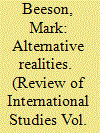

|
|
|
|
|
| Summary/Abstract |
The central argument of this article is that constructivists in particular underestimate or even ignore the importance of the ‘real’ structural inheritance that shapes state (and the political elites that represent them) behaviour. Even though the future is indeterminate, some outcomes are decidedly more likely than others, especially where policymakers believe they inhabit a strategic universe of zero sum outcomes and where self-reliance and assertion remain important. I suggest that ‘critical realism’ offers a way of accounting for the institutional structures that shape international behaviour. The first half of this article makes the case for a critical realist approach. The second half illustrates the possible importance of this claim with reference to the contemporary geopolitics of the Asia-Pacific region.
|
|
|
|
|
|
|
|
|
|
|
|
|
|
|
|
| 3 |
ID:
011459
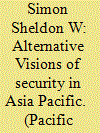

|
|
|
|
|
| Publication |
Fall 1996.
|
| Description |
381-396
|
|
|
|
|
|
|
|
|
|
|
|
|
|
|
|
| 4 |
ID:
107986
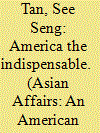

|
|
|
| 5 |
ID:
181188
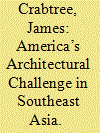

|
|
|
|
|
| Summary/Abstract |
US Vice President Kamala Harris and Secretary of Defense Lloyd J. Austin III have made significant official visits to Southeast Asia. Both sought to address concerns that the US had paid insufficient attention to the region during President Joe Biden's early months in office. But they left unanswered substantial questions about future US strategy as to both the Asia-Pacific as a whole and Southeast Asia in particular. This underlined doubts about Washington's ability to create and develop the kind of regional initiatives, institutions and partnerships that might help to blunt China's rise and draw nations in Southeast Asia back towards the US. To do so, the US will have to marshal deep focus and subtle statecraft to create new diplomatic architecture and set new standards for the region in areas such as trade and new technologies. Otherwise, American influence in the region is likely to decline.
|
|
|
|
|
|
|
|
|
|
|
|
|
|
|
|
| 6 |
ID:
158020
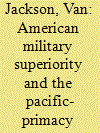

|
|
|
|
|
| Summary/Abstract |
Does the United States seek primacy in Asia? The belief that it does is widespread and long-standing. Scholars and pundits in the United States and around the world routinely reference the condition of primacy in Asia – defined here as unrivalled influence over strategic life1 – as either a means or an end of US strategy, or both. But is it accurate? This matters as much more than a semantic dispute. The presumption of Asian primacy features prominently in debates about US grand strategy. Some see it as a normative good for the United States, the only adequate means for securing US interests abroad.2 Others give the unsustainability of a condition of primacy as reason to favour retrenchment from the United States’ international commitments.3
|
|
|
|
|
|
|
|
|
|
|
|
|
|
|
|
| 7 |
ID:
064177


|
|
|
| 8 |
ID:
109521
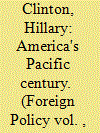

|
|
|
| 9 |
ID:
008125
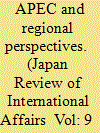

|
|
|
| 10 |
ID:
009109
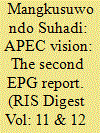

|
|
|
|
|
| Publication |
March 1995.
|
| Description |
29-34
|
|
|
|
|
|
|
|
|
|
|
|
|
|
|
|
| 11 |
ID:
011130
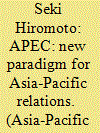

|
|
|
|
|
| Publication |
spring/summer 1996.
|
| Description |
131-136
|
|
|
|
|
|
|
|
|
|
|
|
|
|
|
|
| 12 |
ID:
147769
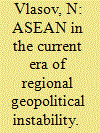

|
|
|
|
|
| Summary/Abstract |
THE ASSOCIATION of Southeast Asian Nations (ASEAN), set up by Indonesia, Malaysia, Singapore, Thailand, and the Philippines in 1967 under the Bangkok Declaration,1 has become an important actor in regional politics. Having extended its membership to Brunei in 1984, to Vietnam in 1995, to Laos and Myanmar in 1997,2 and to Cambodia in 1999, the association brings together ten countries with different economic and political systems. Today, ASEAN is a large market, an area with a population of more than 600 million3 (third place in the world), and a rapidly growing economy with a combined gross domestic product of more than $2.3 trillion4 (seventh place in the world).
|
|
|
|
|
|
|
|
|
|
|
|
|
|
|
|
| 13 |
ID:
180758
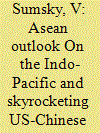

|
|
|
|
|
| Summary/Abstract |
For more than 10 years before that, the idea of the Indo-Pacific as a new regional configuration in the area of the Indian and Pacific Oceans to replace the Asia-Pacific Region construct had been bounced around at various international expert forums and in government circles of some countries, primarily the United States, Japan, Australia, and India. In 2007-2008, those four countries, which are more or less openly seeking to contain the growing economic and naval might of China, tried to create a quadrilateral group. They failed to establish any steady cooperation at that time, and for about the next 10 years, each of them sought to develop its own concept for a new regional formation while regularly attempting to coordinate positions with the other three in unofficial meetings on Indo-Pacific issues.
|
|
|
|
|
|
|
|
|
|
|
|
|
|
|
|
| 14 |
ID:
148558
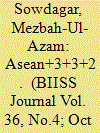

|
|
|
|
|
| Summary/Abstract |
The recent trends of regionalism in the Asia-Pacific region in perspective of the ASEAN+3+3 (Association of South East Asian Nations+China, Japan and Korea+Australia, New Zealand and India), officially known as the East Asia Summit (EAS), are important for international relations. Especially, China’s growing role and influence in this ASEAN centric new international order have attracted scholars of international relations substantially. China responded to the structural changes in East Asia, managed to transform its policies for the region in the mid-1990s and began to engage more actively than before in multilateral frameworks. The involvement of United States (US) in the regionalism has furthered a new political and strategic facet. Particularly, with this engagement, the US has made a big policy shift in the region. Taking into account of this policy shift of the two great powers, US and China, the paper mainly addresses two specific questions. First, what are the invisible dynamics of EAS politics after the US involvement? Second, how are the inside rudiments of security, political and strategic connotation in this regionalism after the US engagement? The paper aims to explain significance of recent trends of EAS centric regional competition and a deeper understanding of the increasing security, political and strategic nuances of the Asia- Pacific regionalism. The paper argues that ASEAN is inviting both powers to compete with each other through its balancing role. In the name of regional grouping, a regional security competition has been started under the umbrella of EAS.
|
|
|
|
|
|
|
|
|
|
|
|
|
|
|
|
| 15 |
ID:
010094
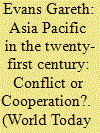

|
|
|
|
|
| Publication |
Feb 1996.
|
| Description |
50-52
|
|
|
|
|
|
|
|
|
|
|
|
|
|
|
|
| 16 |
ID:
016309
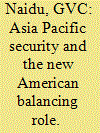

|
|
|
|
|
| Publication |
Jun 1993.
|
| Description |
251-263
|
|
|
|
|
|
|
|
|
|
|
|
|
|
|
|
| 17 |
ID:
192141
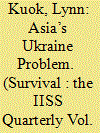

|
|
|
|
|
| Summary/Abstract |
Many Asian governments regard Russia’s war with Ukraine as a distant event with limited impact on the region, beyond rising food and energy prices and possibly increasing the risk of China attacking Taiwan. But the war has strained the rule of law and is entrenching ideological divisions, introducing unnecessary complexity into alliances and partnerships. Asian governments should be alert to the negative implications of these developments for regional peace and security. For them to condemn Russia’s invasion of Ukraine and defend the rule of law would not be to blindly support the West, and would be entirely consistent with their national interests. The West, for its part, should avoid worsening geopolitical fault lines. To this end, the United States might refrain from characterising great-power competition as a battle between autocracies and democracies, and from painting China and Russia with the same broad ideological brush.
|
|
|
|
|
|
|
|
|
|
|
|
|
|
|
|
| 18 |
ID:
012749
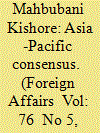

|
|
|
|
|
| Publication |
Sept-Oct 1997.
|
| Description |
149-58
|
|
|
|
|
|
|
|
|
|
|
|
|
|
|
|
| 19 |
ID:
011252
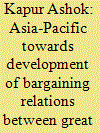

|
|
|
|
|
| Publication |
1996.
|
| Description |
441-453
|
|
|
|
|
|
|
|
|
|
|
|
|
|
|
|
| 20 |
ID:
159681
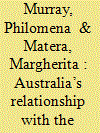

|
|
|
|
|
| Summary/Abstract |
After decades of tension, Australia and the European Union (EU) now have a substantive relationship, interacting and cooperating with each other within a wide range of areas. The relationship is currently at a critical turning point. The Framework Agreement has, for the first time, elevated the relationship to a treaty level. It strengthens Australia–EU actions and interests on bilateral, regional and multilateral issues. There is considerable potential for closer cooperation and more extensive pooling of the resources and capacities of both interlocutors on a range of policies and within the multilateral context. This article provides an assessment of the relationship, the current state of play and key challenges facing the relationship as the EU and Australia forge stronger ties through the conclusion of a Framework Agreement and the commencement of discussions on a Free Trade Agreement at the same time as the UK’s exit negotiations from the EU. It demonstrates that, although there are challenges facing the relationship, there are also significant opportunities to further develop and strengthen ties.
|
|
|
|
|
|
|
|
|
|
|
|
|
|
|
|